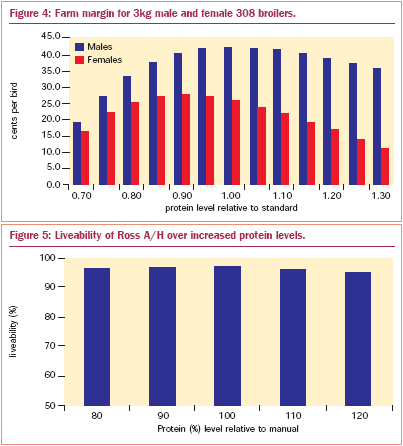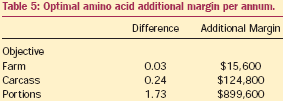



What protein level will maximise your profits
By Marcus Kenny, Carolyne Kemp and Colin Fisher, Aviagen - This article by Aviagen explains the need for varying dietary protein in order to maximise profits in a broiler operation.
Aviagen publish nutrient
density recommendations for diets
fed to broilers in the starter, grower
& finisher period (Table 1), with the
comment that the nutrient levels
need to be adjusted to maximise
profitability under local conditions.
It is now widely accepted that the
choice of dietary protein level is an
economic decision to be made for
each company or enterprise. This
idea replaces the concept that birds
have characteristic ‘requirements’
which should be met under all
conditions.
The effect of dietary protein level on biological performance
Results from a recent Aviagen
trial demonstrated the effect of
increasing protein levels in the diet
on Ross 308 male growth and FCR
to 41 days of age and were
consistent with previous trials and
field experience. The control
treatment was formulated to meet
the current Ross 308
recommendations while the protein
level in the trial treatment was
formulated to achieve 85% of the
control diet level.

In this article, protein refers to
available amino acids and all trial
diets were designed to provide
different levels of balanced protein
using the ideal amino acid profile as
per the recommendations published
in the Ross Broiler Manual (2002).
It can be clearly seen from Figure
1 that bodyweight and FCR improve
significantly as protein levels are
increased. A lower dietary protein
also affects white (breast) and dark
(leg) meat yield. This effect is shown
in Figure 2.

However, a lower protein level in
the diet will be a cheaper
formulation, so the effect on the
overall financial performance of the
flock needs to be assessed. Table 2
shows the margin per bird after feed
cost for each diet. Although feed
price has been reduced on the lower
(85%) protein diet the margin is
significantly reduced. Even in a
situation where feed prices increase
by 10%, the reduced protein
treatment results in a lower margin
than the control diet.

The balanced protein calculator
The example above demonstrates
the impact of two very different
levels of protein but does not
indicate what level of protein
optimises margin. To identify this,
Aviagen have developed the
Balanced Protein Calculator. This
calculator is a tool which combines
feed and revenue prices with broiler
biological response data to establish
the dietary amino acid level that
maximises profit for different
objectives e.g. farm versus
eviscerated carcase margin. The
biological response data is derived
from a compilation of Aviagen
amino acid response trials.
The calculation of an optimum
balanced protein level involves
several inputs (Figure 3) Feed cost
at different protein levels is
determined by conventional leastcost
feed formulation based on
relevant raw material costs. Costs of
broiler rearing and processing are
also used. Broiler performance at
each protein level is then
determined from response curves
established from trial data and the
revenue from different types of end
product and costs are identified.
These elements are then combined
to calculate the profit for each level
of balanced protein.

Biological response data
The most important part of the Balanced Protein Calculator is the set of biological response data. The data has been obtained by evaluating the amino acid response of the Ross 308 broiler in an ongoing series of trials between 2002 and 2004. In total 72 responses have been identified.
Calculating bird response
To combine the data from different trials all data were expressed relative to this treatment for the definition of bird response to protein. Slaughter weights of 1.7kg, 2.0kg. 2.5kg and 3.0kg for males and females separately were considered in the analysis.
Calculating costs, revenue and optimum amino acid level for an enterprise
Feed costs were calculated for
protein levels of 70% to 130% of
the Ross manual recommendation.
Other costs such as chick cost and
processing costs were also taken
into consideration.
The calculation of profit requires
data for the various sources of
income accruing to the enterprise;
the value of live birds (per kg), of
eviscerated carcass (per kg) and of
portions.

Calculating the optimum amino acid level
The output from the calculation is
a plot of profit against relative
protein level and an example of
farm growing margin is shown in
Figure 4.
In the example, feed cost data
were based on ingredient prices in
Asia for the range of dietary protein
levels. Revenues were estimated at
0.75 USD per kg live weight, 1.25
USD per kg eviscerated carcass,
1.80 USD per kg breast meat and
2.05 USD per kg for leg meat.
Estimated costs for chicks, broiler
grower overheads and processing
were constant for all protein levels.
The optimum amino acid level for
maximum profit can also be
calculated for eviscerated carcass
and processed portions. Table 3
summarises this data for males,
females and as hatched birds grown
to 3kg.
The optimal amino acid density
for as hatched farm margin is 96%
of the current Ross manual
recommendations but for as
hatched, portioned birds optimum
margin is achieved at 106% amino
acid density. As you would expect,
the level of dietary protein most
profitable, increases as additional
sources of revenue are brought into
consideration.
The responsiveness of the Ross
broiler to increased amino acids
explains why the optimal amino
acid density for portions products is
higher than that for farm margin.
An additional factor influencing
this economic response is the high
liveability of the Ross broiler. The
Aviagen pedigree selection process
has minimised the incidence of
metabolic related diseases even at
high growth rates, hence feeding
higher levels of nutrients to the
Ross bird will not compromise
liveability. Figure 5 below shows the
liveability of Ross as hatched birds
to increasing levels of protein and
demonstrates that feeding the Ross
bird for optimal performance does
not compromise the welfare of the
bird.

The cost of optimal amino acid density on financial performance
 Using the Balanced Protein
Calculator, can therefore provide
information on the level of dietary
amino acids most
appropriate to
meet the
production
objectives of the
organisation
As can be seen
from Table 4, the
difference in
margin can be significant especially
for an operation portioning product.
For an operation producing 1
million broilers per week,
profitability can be considerably
enhanced by increasing dietary
protein levels to 106% of those
recommended in the Ross manual
as seen in table 5.
Using the Balanced Protein
Calculator, can therefore provide
information on the level of dietary
amino acids most
appropriate to
meet the
production
objectives of the
organisation
As can be seen
from Table 4, the
difference in
margin can be significant especially
for an operation portioning product.
For an operation producing 1
million broilers per week,
profitability can be considerably
enhanced by increasing dietary
protein levels to 106% of those
recommended in the Ross manual
as seen in table 5.
Summary
The optimal amino acid density depends on the objectives of the organisation.
Aviagen have collated a unique set of biological response data showing how the Ross broiler responds to inputs of balanced amino acids.
The Balanced Protein Calculator combines biological response data with feed and revenue prices to identify the optimal dietary amino acid level to maximise farm, eviscerated and portions margin.
Maximum farm margin will be achieved at current Ross recommendations.
Maximum margins in companies deboning a large proportion of product will be achieved when higher levels of dietary amino acids are fed.
The excellent liveability of the Ross broiler allows profitability to be maximised without compromising welfare.









